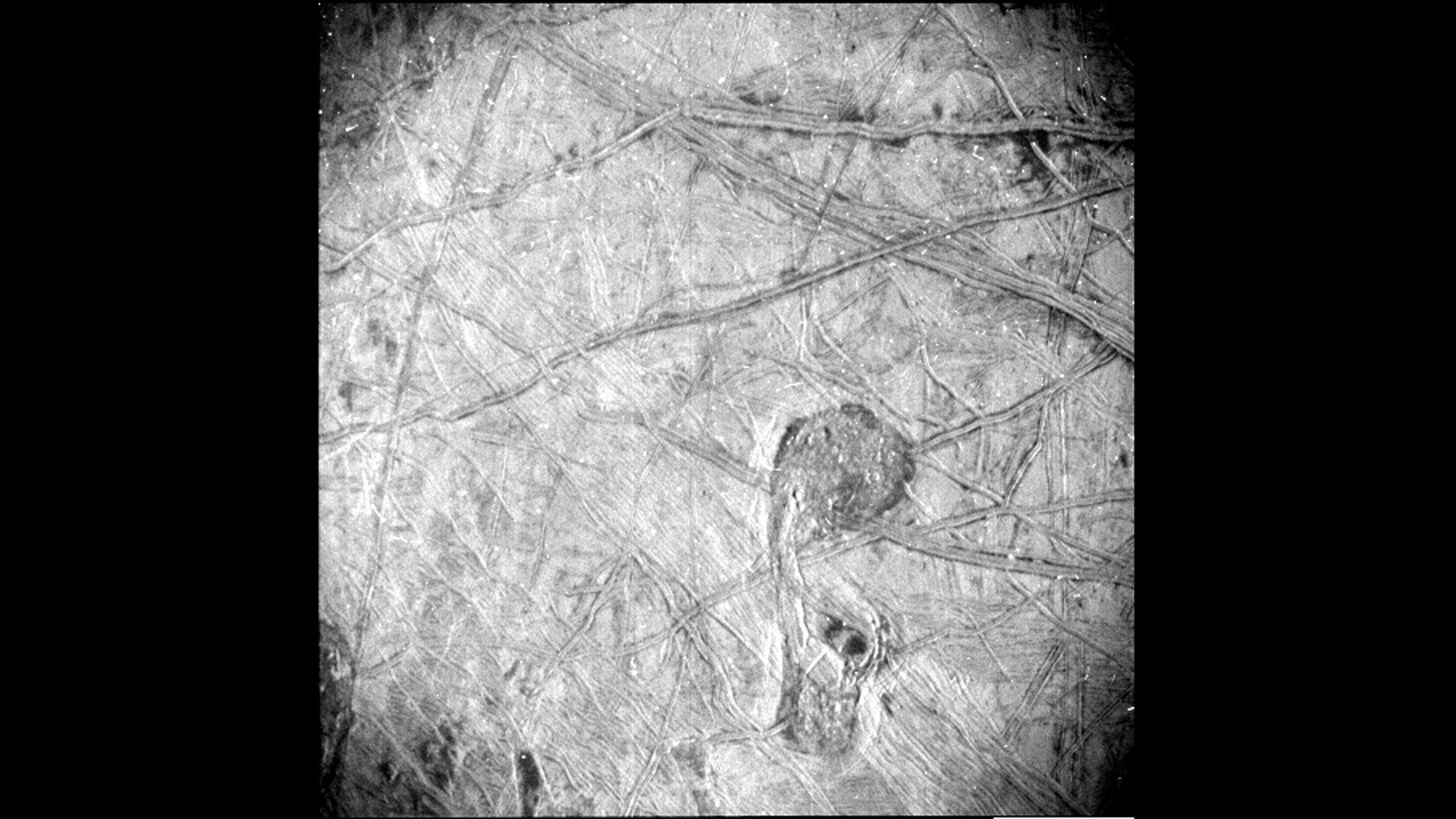NASA's Juno spacecraft snaps its most detailed view of Jupiter's icy moon Europa
The landscape in the image is only illuminated by Jupiter's night glow.

NASA's Jupiter-exploring Juno spacecraft captured its most detailed image of the ice-covered, ocean-bearing moon Europa, which scientists think is one of the likeliest places in the solar system to host extraterrestrial life.
The image, taken last week during Juno's close flyby of the mysterious moon, reveals a frozen surface criss-crossed by ridges and grooves, as well as a plethora of unusual features. Dark blotches stain the ice in the upper right corner of the image and to the bottom right of center, which, scientists believe, may have been produced by material bubbling up from the depths of Europa's ocean and erupting onto the ice.
The image, which depicts an area 93 miles (150 kilometers) long and 125 miles (200 km) wide, also reveals a strange depression shaped like a musical quarter note sprawling for 42 miles (67 km) from north to south and for 23 miles (37 km) from east to west in the lower half of the image. The tiny white dots scattered all over the image, scientists said in a statement, are "signatures of penetrating high-energy particles from the severe radiation environment around the moon."
Related: NASA flyby of Jupiter's big moon Ganymede reveals auroras and huge unknown craters
Juno took the image on Sept. 29 when it performed its closest ever pass of Europa, hurtling at 15 mps (24 kps) about 256 miles (412 km) above the moon's icy shell. The images offer scientists their most detailed views of Europa's surface since the Galileo probe's flyby in 2000.
Juno took the image using its Stellar Reference Unit camera (SRU), which usually helps Juno maintain its orientation by determining the spacecraft's position with respect to the stars in the surrounding cosmos, but during the flyby the SRU doubled up as a science instrument, capturing the stunning black-and-white image.
The image shows Europa's surface at a resolution of 840 to 1,115 feet (256 to 340 m) per pixel. Interestingly, SRU took the image at night, when the only light illuminating the moon was that reflected off the tops of Jupiter's clouds.
Get the Space.com Newsletter
Breaking space news, the latest updates on rocket launches, skywatching events and more!
"This image is unlocking an incredible level of detail in a region not previously imaged at such resolution and under such revealing illumination conditions," Heidi Becker, the lead co-investigator for the SRU said in the statement. "The team's use of a star-tracker camera for science is a great example of Juno's groundbreaking capabilities. These features are so intriguing. Understanding how they formed — and how they connect to Europa's history — informs us about internal and external processes shaping the icy crust."
SRU previously proved its value in taking images in low light conditions when it snapped photos of Jupiter's feeble rings and discovered shallow lightning in Jupiter's atmosphere.
Juno's primary science objective was to solely focus on the gas giant Jupiter, but when the mission got extended last year, scientists were able to schedule some observation time for three of the planet's four main moons.
In June 2021, Juno made a close flyby at Ganymede, the largest moon in the entire solar system, taking similarly striking images.
"With this flyby of Europa, Juno has now seen close-ups of two of the most interesting moons of Jupiter, and their ice shell crusts look very different from each other," Scott Bolton, a physicist at Southwest Research Institute in San Antonio and Juno principal investigator, said in the statement. "In 2023, Io, the most volcanic body in the solar system, will join the club."
Scientists are still analyzing data collected during the recent Europa flyby, hoping to learn more about the intriguing world, which many believe might host microbial life in the depths of its subsurface ocean. Juno, however, is unlikely to find out whether anything lives under Europa's frozen crust.
NASA's Europa Clipper mission, scheduled to launch in 2024 with the sole purpose of studying Europa, may have a better chance of answering that big question. Fitted with a suite of nine high-tech instruments, Europa Clipper will learn everything there is to learn about the moon without needing to land on its surface. The Juno images will help guide Europa Clipper mission planning.
Europa is the solar system's sixth-largest moon, only about 10% smaller than Earth's moon.
Follow Tereza Pultarova on Twitter @TerezaPultarova. Follow us on Twitter @Spacedotcom and on Facebook.
Join our Space Forums to keep talking space on the latest missions, night sky and more! And if you have a news tip, correction or comment, let us know at: community@space.com.

Tereza is a London-based science and technology journalist, aspiring fiction writer and amateur gymnast. Originally from Prague, the Czech Republic, she spent the first seven years of her career working as a reporter, script-writer and presenter for various TV programmes of the Czech Public Service Television. She later took a career break to pursue further education and added a Master's in Science from the International Space University, France, to her Bachelor's in Journalism and Master's in Cultural Anthropology from Prague's Charles University. She worked as a reporter at the Engineering and Technology magazine, freelanced for a range of publications including Live Science, Space.com, Professional Engineering, Via Satellite and Space News and served as a maternity cover science editor at the European Space Agency.









